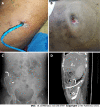Drainage of pancreatic fluid collections in acute pancreatitis: A comprehensive overview
- PMID: 36051118
- PMCID: PMC9297419
- DOI: 10.12998/wjcc.v10.i20.6769
Drainage of pancreatic fluid collections in acute pancreatitis: A comprehensive overview
Abstract
Moderately severe and severe acute pancreatitis is characterized by local and systemic complications. Systemic complications predominate the early phase of acute pancreatitis while local complications are important in the late phase of the disease. Necrotic fluid collections represent the most important local complication. Drainage of these collections is indicated in the setting of infection, persistent or new onset organ failure, compressive or pressure symptoms, and intraabdominal hypertension. Percutaneous, endoscopic, and minimally invasive surgical drainage represents the various methods of drainage with each having its own advantages and disadvantages. These methods are often complementary. In this minireview, we discuss the indications, timing, and techniques of drainage of pancreatic fluid collections with focus on percutaneous catheter drainage. We also discuss the novel methods and techniques to improve the outcomes of percutaneous catheter drainage.
Keywords: Catheters; Collections; Debridement; Drainage; Pancreatitis, Acute necrotizing; Stents; Therapeutic irrigation.
©The Author(s) 2022. Published by Baishideng Publishing Group Inc. All rights reserved.
Conflict of interest statement
Conflict-of-interest statement: There is no conflict of interest associated with any of the senior author or other coauthors contributed their efforts in this manuscript.
Figures










Similar articles
-
American Gastroenterological Association Clinical Practice Update: Management of Pancreatic Necrosis.Gastroenterology. 2020 Jan;158(1):67-75.e1. doi: 10.1053/j.gastro.2019.07.064. Epub 2019 Aug 31. Gastroenterology. 2020. PMID: 31479658 Review.
-
Endoscopic Interventions in Acute Pancreatitis: What the Advanced Endoscopist Wants to Know.Radiographics. 2018 Nov-Dec;38(7):2002-2018. doi: 10.1148/rg.2018180066. Epub 2018 Sep 28. Radiographics. 2018. PMID: 30265612 Review.
-
Management of pancreatic fluid collections: A comprehensive review of the literature.World J Gastroenterol. 2016 Feb 21;22(7):2256-70. doi: 10.3748/wjg.v22.i7.2256. World J Gastroenterol. 2016. PMID: 26900288 Free PMC article. Review.
-
Multidisciplinary Management of Complicated Pancreatitis: What Every Interventional Radiologist Should Know.AJR Am J Roentgenol. 2021 Oct;217(4):921-932. doi: 10.2214/AJR.20.25168. Epub 2021 Jan 20. AJR Am J Roentgenol. 2021. PMID: 33470838 Review.
-
Intraluminal endoscopy in diagnosis and treatment of fluid collections in acute pancreatitis.Khirurgiia (Mosk). 2022;(8):31-37. doi: 10.17116/hirurgia202208131. Khirurgiia (Mosk). 2022. PMID: 35920220 English, Russian.
Cited by
-
Role of imaging in evaluating the complications of endoscopic management of pancreatic fluid collections in acute pancreatitis.Abdom Radiol (NY). 2024 Jul;49(7):2449-2458. doi: 10.1007/s00261-024-04348-y. Epub 2024 May 20. Abdom Radiol (NY). 2024. PMID: 38763937 Review.
-
Surgical management of acute pancreatitis: Historical perspectives, challenges, and current management approaches.World J Gastrointest Surg. 2023 Mar 27;15(3):307-322. doi: 10.4240/wjgs.v15.i3.307. World J Gastrointest Surg. 2023. PMID: 37032793 Free PMC article. Review.
-
Management of infected acute necrotizing pancreatitis.World J Clin Cases. 2023 Jan 16;11(2):482-486. doi: 10.12998/wjcc.v11.i2.482. World J Clin Cases. 2023. PMID: 36686342 Free PMC article.
-
Early vs. late percutaneous catheter drainage of acute necrotic collections in patients with necrotizing pancreatitis.Abdom Radiol (NY). 2023 Jul;48(7):2415-2424. doi: 10.1007/s00261-023-03883-4. Epub 2023 Apr 17. Abdom Radiol (NY). 2023. PMID: 37067560
-
Application of deep learning models for accurate classification of fluid collections in acute necrotizing pancreatitis on computed tomography: a multicenter study.Abdom Radiol (NY). 2025 May;50(5):2258-2267. doi: 10.1007/s00261-024-04607-y. Epub 2024 Sep 30. Abdom Radiol (NY). 2025. PMID: 39347977
References
-
- Foster BR, Jensen KK, Bakis G, Shaaban AM, Coakley FV. Revised Atlanta Classification for Acute Pancreatitis: A Pictorial Essay. Radiographics. 2016;36:675–687. - PubMed
-
- Banks PA, Bollen TL, Dervenis C, Gooszen HG, Johnson CD, Sarr MG, Tsiotos GG, Vege SS Acute Pancreatitis Classification Working Group. Classification of acute pancreatitis--2012: revision of the Atlanta classification and definitions by international consensus. Gut. 2013;62:102–111. - PubMed
-
- Trikudanathan G, Tawfik P, Amateau SK, Munigala S, Arain M, Attam R, Beilman G, Flanagan S, Freeman ML, Mallery S. Early (<4 Weeks) Versus Standard (≥ 4 Weeks) Endoscopically Centered Step-Up Interventions for Necrotizing Pancreatitis. Am J Gastroenterol. 2018;113:1550–1558. - PubMed
-
- Oblizajek N, Takahashi N, Agayeva S, Bazerbachi F, Chandrasekhara V, Levy M, Storm A, Baron T, Chari S, Gleeson FC, Pearson R, Petersen BT, Vege SS, Lennon R, Topazian M, Abu Dayyeh BK. Outcomes of early endoscopic intervention for pancreatic necrotic collections: a matched case-control study. Gastrointest Endosc. 2020;91:1303–1309. - PubMed
-
- van Grinsven J, van Brunschot S, van Baal MC, Besselink MG, Fockens P, van Goor H, van Santvoort HC, Bollen TL Dutch Pancreatitis Study Group. Natural History of Gas Configurations and Encapsulation in Necrotic Collections During Necrotizing Pancreatitis. J Gastrointest Surg. 2018;22:1557–1564. - PubMed
Publication types
LinkOut - more resources
Full Text Sources

